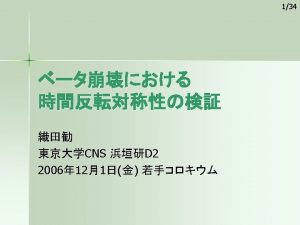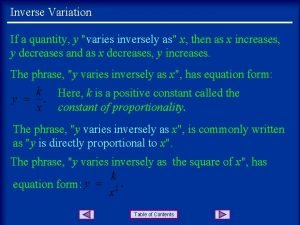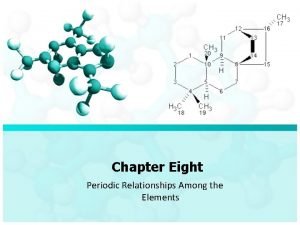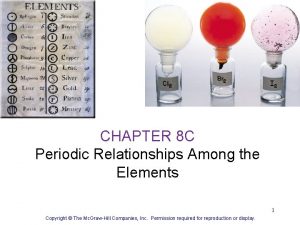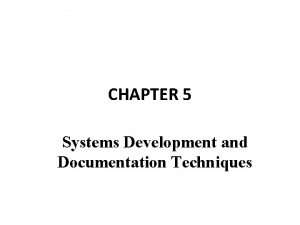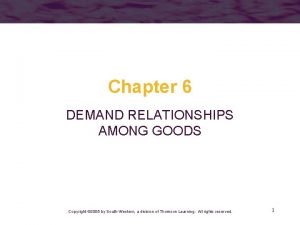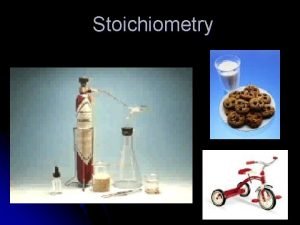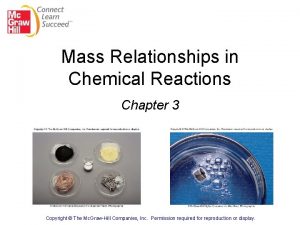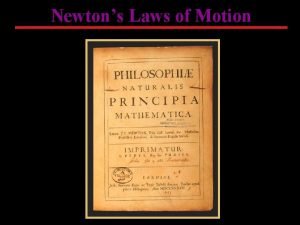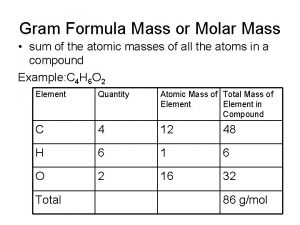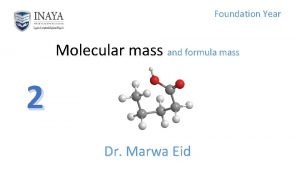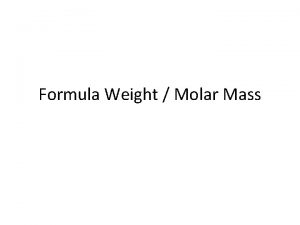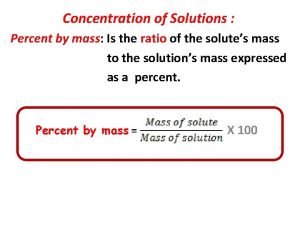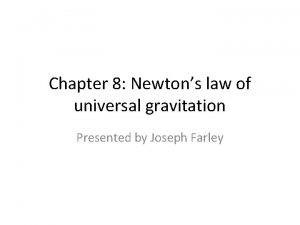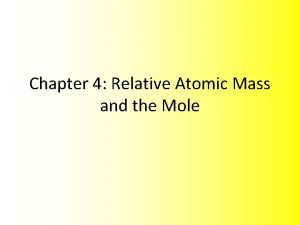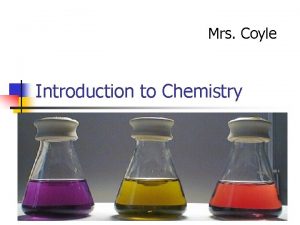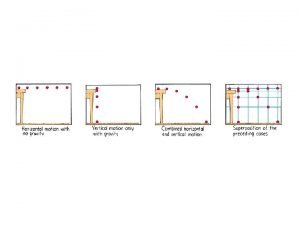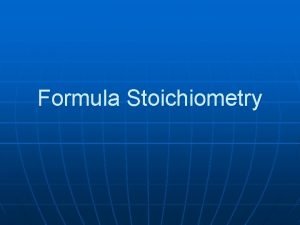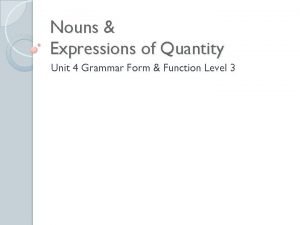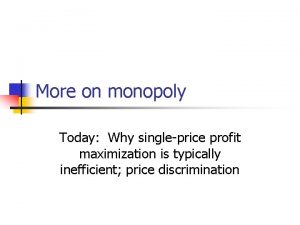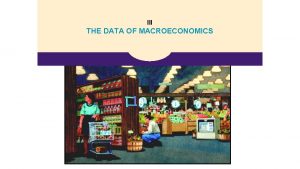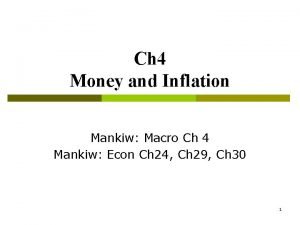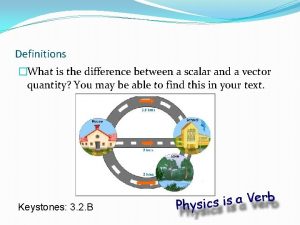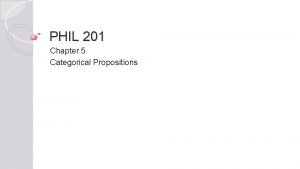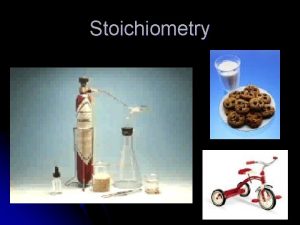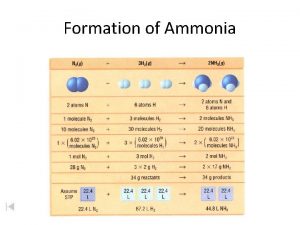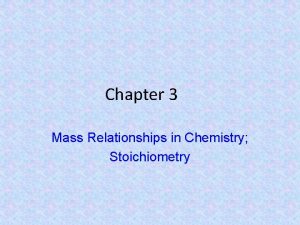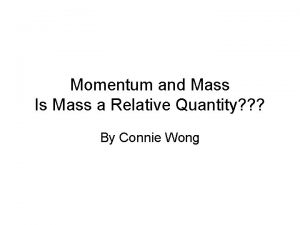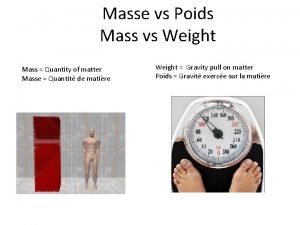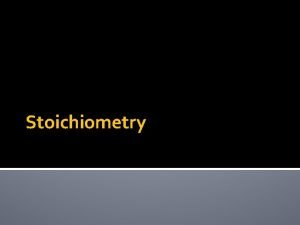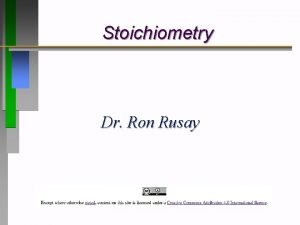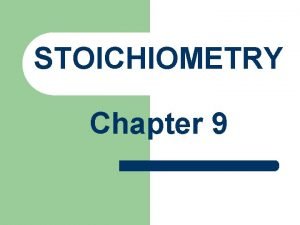Stoichiometry Stoichiometry Stoichiometry mass and quantity relationships among


















































- Slides: 50

Stoichiometry

Stoichiometry • Stoichiometry- mass and quantity relationships among reactants and products in a chemical reaction • Chemists use balanced chemical equations as a basis to calculate how much reactant is needed or product is formed in a reaction

Stoichiometry • How is a balanced equation like a recipe? -A balanced chemical equation provides the same kind of quantitative information

Solving Stoichiometry Problems 1. List what you know 2. Set up the problem 3. Estimate and calculate

Example • An equation can represent the manufacturing of a single tricycle:

Example • In a five-day workweek, Tiny Tyke is scheduled to make 640 tricycles. How many wheels should be in the plant on Monday morning to make these tricycles? • Knowns: • Number of tricycles = 640 FSW 3 HP 2 • F + S + 3 W + H + 2 P = FSW 3 HP 2

Example • Two conversion factors: 3 W 1 FSW 3 HP 2 3 W • Calculate: • 640 FSW 3 HP 2 X 3 W = 1920 W 1 FSW 3 HP 2

Stoichiometry • A balanced chemical equation can be interpreted in terms of different quantities, including numbers of atoms, molecules, or moles; mass; and volume.

Stoichiometry • Number of Atoms

Stoichiometry • Number of Molecules

Stoichiometry • Moles

Stoichiometry • Mass

Stoichiometry • Volume

Stoichiometry • Mass and atoms are conserved in every chemical reaction

Interpreting a Balanced Chemical Equation • Example: Hydrogen sulfide, which smells like rotten eggs, is found in volcanic gases. The balanced equation for the burning of hydrogen sulfide is: 2 H 2 S(g) + 3 O 2(g) --- > 2 SO 2(g) + 2 H 2 O(g) • Looking at the coefficients, you can determine the relative amounts of molecules or moles of reactants and products

Interpreting a Balanced Chemical Equation • Example Continued: • 2 molecules H 2 S + 3 molecules O 2 - • 2 molecules SO 2 + 2 molecules H 2 O • 2 mol H 2 S + 3 mol O 2 - • 2 mol SO 2 + 2 mol H 2 O

Interpreting a Balanced Chemical Equation • Example Continued: 2 mol H 2 S + 3 mol O 2 2 mol SO 2 + 2 mol H 20 (2 mol X 34. 1 g/mol) + (3 mol X 32 g/mol) -> (2 mol X 64. 1 g/mol) + (2 mol X 18. 0 g/mol) 68. 2 g H 2 S + 96. 0 g O 2 -> 128. 2 g SO 2 + 36. 0 g H 2 O 164. 2 g = 164. 2 g

Writing and Using Mole Ratios • In chemical calculations, mole ratios are used to convert between: - moles of reactant and moles of product, between moles of reactants, or between moles of products

Writing and Using Mole Ratios • Mole-Mole Calculations – Mole ratio- is a conversion factor derived from the coefficients of a balanced chemical equation interpreted in terms of moles

Writing and Using Mole Ratios • To determine the number of moles in a sample of a compound, first measure the mass of the sample • Then use the molar mass to calculate the number of moles in that mass

Calculating Moles of a Product • How many moles of ammonia are produced when 0. 60 mol of nitrogen reacts with hydrogen? • Known: moles of nitrogen = 0. 60 mol N 2 • 0. 60 mol N 2 X 2 mol NH 3 = 1. 2 mol NH 3 1 mol N 2 Ratio of 1. 2 mol NH 3 to 0. 60 mol H 2 is 2: 1 N 2 + 3 H 2 --- 2 NH 3

Calculating the Mass of a Product –Mass-Mass Calculations

Calculating the Mass of a Product • Calculate the number of grams of NH 3 produced by the reaction of 5. 40 g of hydrogen with an excess of nitrogen. The balanced equation is: N 2(g) + 3 H 2(g) - 2 NH 3(g) • Known: • Mass of hydrogen = 5. 40 g H 2 • 3 mol H 2 = 2 mol NH 3 (from equation) • 1 mol H 2 = 2. 0 g H 2 (molar mass) • 1 mol NH 3 = 17. 0 g NH 3 (molar mass)

Calculating the Mass of a Product • Example Continued: Steps: g H 2 mol NH 3 g NH 3 5. 40 g H 2 X 1 mol H 2 X 2 mol NH 3 2. 0 g H 2 3 mol H 2 X 17. 0 g NH 3 = 31 g NH 3 1 mol NH 3

Other Stoichiometric Calculations • In a typical stoichiometric problem: - the given quantity is first converted to moles - then the mole ratio from the balanced equation is used to calculate the number of moles of the wanted substance - finally the moles are converted to any other unit of measurement related to the unit mole

Other Stoichiometric Calculations • Solution Diagram:

Other Stoichiometric Calculations • Problem-Solving Approach:

Calculating Molecules of a Product • How many molecules of oxygen are produced when 29. 2 g of water is decomposed by electrolysis according to this balanced equation? 2 H 2 O(l) electricity 2 H 2(g) + O 2(g)

Calculating Molecules of a Product • Example Continued: • Known: • Mass of water = 29. 2 g H 2 O • 2 mol H 2 O = 1 mol O 2 (from equation) • 1 mol H 2 O = 18. 0 g H 2 O (molar mass) • 1 mol O 2 = 6. 02 X 1023 molecules O 2 Follow: g H 2 O mol O 2 molecules O 2

Calculating Molecules of a Product • Example Continued: 29. 2 g H 2 O X 1 mol O 2 18. 0 g H 2 O 2 mol H 2 O X 6. 02 X 1023 molecules O 2 1 mol O 2 = 4. 88 X 1023 molecules O 2

Volume-Volume Stoichiometric Calculations • Nitrogen monoxide and oxygen gas combine to form the brown gas nitrogen dioxide, which contributes to photochemical smog. How many liters of nitrogen dioxide are produced when 34 L of oxygen reacts with an excess of nitrogen monoxide? Assume conditions of Standard Temperature and Pressure. 2 NO(g) + O 2(g) ----- 2 NO 2(g)

Volume-Volume Stoichiometric Calculations • • • Example Continued: Known: Volume of oxygen = 34 L O 2 2 mol NO 2 / 1 mol O 2 (mol ratio) 1 mol O 2 = 22. 4 L O 2 (at STP) 1 mol NO 2 = 22. 4 L NO 2 (at STP)

Volume-Volume Stoichiometric Calculations • Example Continued: 34 L O 2 X 1 mol O 2 X 2 mol NO 2 22. 4 L O 2 1 mol O 2 X 22. 4 L NO 2 = 68 L NO 2 1 mol NO 2

Finding the Volume of a Gas Needed for a Reaction • Assuming STP, how many milliliters of oxygen are needed to produce 20. 4 m. L SO 3 according to this balanced equation? 2 SO 2(g) + O 2(g) --- 2 SO 3(g) • Known: • Volume of sulfur trioxide = 20. 4 m. L • 2 m. L SO 3 / 1 m. L O 2 (volume ratio)

Volume-Volume Stoichiometric Calculations • Example Continued: 20. 4 m. L SO 3 X 1 m. L O 2 2 m. L SO 3 = 10. 2 m. L O 2

Limiting and Excess Reagents • In a chemical reaction, an insufficient quantity of any of the reactants will limit the amount of product that forms. – limiting reagent- is the reagent that determines the amount of product that can be formed by a reaction – Excess Reagent- the reagent that is not used up

Limiting and Excess Reagents The Chemical Equation for the Preparation of Ammonia:

Determining the Limiting Reagent in a Reaction • Copper reacts with sulfur to form copper(I) sulfide according to the following equation. 2 Cu(s) + S(s) - Cu 2 S(s) • What is the limiting reagent when 80. 0 g Cu reacts with 25. 0 g S? • Known: • Mass of copper = 80. 0 g Cu • Mass of sulfur = 25. 0 g S

Determining the Limiting Reagent in a Reaction • Example Continued: Steps: g Cu -- mol Cu g S --- mol S mol Cu -- mol S

Determining the Limiting Reagent in a Reaction • Example Continued: 80. 0 g Cu X 1 mol Cu = 1. 26 mol Cu 63. 5 g Cu 25. 0 g S X 1 mol S = 0. 779 mol S 32. 1 g S 1. 26 mol Cu X 1 mol S = 0. 630 mol S 2 mol Cu

Determining the Limiting Reagent in a Reaction • Example Continued: • You can compare the amount of sulfur needed (0. 630 mol S) with the given amount (0. 779 mol S). - indicates sulfur is in excess - copper is the limiting reagent

Using a Limiting Reagent to Find the Quantity of a Product • What is the maximum number of grams of Cu 2 S that can be formed when 80. 0 g Cu reacts with 25. 0 g S? 2 Cu(s) + S(s) --- Cu 2 S(s) • Known: • Limiting reagent = 1. 26 mol Cu • 1 mol Cu 2 S = 159. 1 g Cu 2 S (molar mass)

Using a Limiting Reagent to Find the Quantity of a Product • Example Continued: • Steps: mol Cu 2 S g Cu 2 S 1. 26 mol Cu X 1 mol Cu 2 S X 159. 1 g Cu 2 S 2 mol Cu 1 mol Cu 2 S = 1. 00 X 102 g Cu 2 S = mole ratio = 1 mol Cu 2 S / 2 mol Cu

Percent Yield • Percent yield is a measure of the efficiency of a reaction carried out in the laboratory – Example: A batting average is actually a percent yield.

Percent Yield • Theoretical yield- maximum amount of product that could be formed from given amounts of reactants • Actual yield- the amount of product that actually forms when the reaction is carried out in the laboratory

Percent Yield • Percent yield- is the ratio of the actual yield to theoretical yield expressed as a percent

Calculating the Theoretical Yield of a Reaction • Calcium carbonate, which is found in seashells, is decomposed by heating. The balanced equation for this reaction is: Δ • • Ca. CO 3(s) Ca. O(s) + CO 2(g) Known: Mass of calcium carbonate=24. 8 g Ca. CO 3 1 mol Ca. CO 3 = 100. 1 g Ca. CO 3 1 mol Ca. O = 56. 1 g Ca. O

Calculating the Theoretical Yield of a Reaction • Example Continued: Steps: g Ca. CO 3 mol Ca. O g Ca. O 24. 8 g Ca. CO 3 X 1 mol Ca. O 100. 1 g Ca. CO 3 1 mol Ca. CO 3 X 56. 1 g Ca. O 1 mol Ca. O = 13. 9 g Ca. O

Calculating the Percent Yield of a Reaction • What is the percent yield if 13. 1 g Ca. O is actually produced when 24. 8 g Ca. CO 3 is heated? Δ Ca. CO 3(s) Ca. O(s) + CO 2(g) • Known: • Actual yield = 13. 1 g Ca. O • Theoretical yield = 13. 9 g Ca. O

Calculating the Percent Yield of a Reaction • Example Continued: percent yield = actual yield theoretical yield X 100% Percent yield = 13. 1 g Ca. O X 100% = 94. 2% 13. 9 g Ca. O
 Stoichiometry example
Stoichiometry example Stoichiometry worksheet #2 (mole-mass mass-mole problems)
Stoichiometry worksheet #2 (mole-mass mass-mole problems) Examples of scalar quantities
Examples of scalar quantities Vector quantity
Vector quantity A scalar quantity has only got magnitude not
A scalar quantity has only got magnitude not Polar and axial vector pdf
Polar and axial vector pdf A quantity t varies inversely with a quantity
A quantity t varies inversely with a quantity Periodic relationships among the elements
Periodic relationships among the elements Periodic relationships among the elements
Periodic relationships among the elements A flowchart that depicts the relationships among the input
A flowchart that depicts the relationships among the input Periodic relationships
Periodic relationships Demand relationships among goods
Demand relationships among goods Mole mass and mole volume relationships
Mole mass and mole volume relationships Stoichiometry molar mass
Stoichiometry molar mass Mass relationships in chemical reactions
Mass relationships in chemical reactions Relative formula mass of hcl
Relative formula mass of hcl Distinguish between mass number and atomic mass.
Distinguish between mass number and atomic mass. How to calculate abundance in isotopes
How to calculate abundance in isotopes Magnesium atomic number
Magnesium atomic number Percentage composition of propane
Percentage composition of propane Inertial mass vs gravitational mass
Inertial mass vs gravitational mass Grams to mol
Grams to mol Molecular mass
Molecular mass Molar mass def
Molar mass def Convert from mass to moles
Convert from mass to moles Units for molar mass
Units for molar mass Mass/mass problems
Mass/mass problems Gravitational mass vs inertial mass
Gravitational mass vs inertial mass Formula mass
Formula mass Cl- molar mass
Cl- molar mass Atomicity
Atomicity Formula mass vs molar mass
Formula mass vs molar mass Concentration of solution
Concentration of solution Inertial mass vs gravitational mass
Inertial mass vs gravitational mass Co2 relative molecular mass
Co2 relative molecular mass Atomic mass vs molar mass
Atomic mass vs molar mass Mrs_coyle
Mrs_coyle A rocket of mass 12000 kg accelerates vertically
A rocket of mass 12000 kg accelerates vertically Formula mass vs gram formula mass
Formula mass vs gram formula mass Formula mass vs gram formula mass
Formula mass vs gram formula mass Cold air mass overtakes warm air mass
Cold air mass overtakes warm air mass Compound noun of hair
Compound noun of hair Single price monopoly
Single price monopoly How to calculate real gdp from price and quantity
How to calculate real gdp from price and quantity Change in supply vs change in quantity supplied
Change in supply vs change in quantity supplied Supply and demand curve shifts
Supply and demand curve shifts 4. velocity and the quantity equation
4. velocity and the quantity equation Scalar versus vector
Scalar versus vector Difference between quality and quantity
Difference between quality and quantity Scalar and vector quantity difference
Scalar and vector quantity difference Obversion logic
Obversion logic





